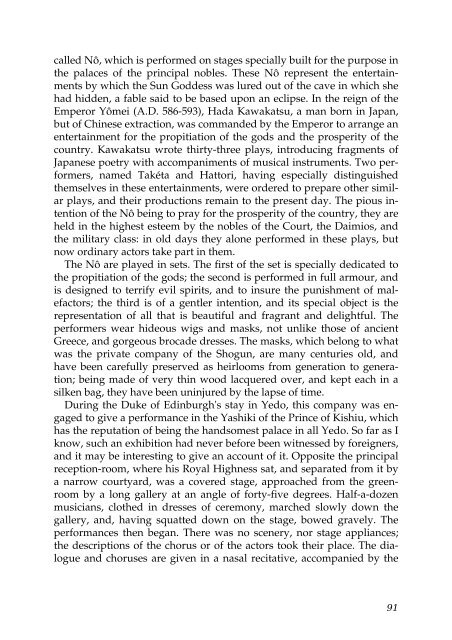Create successful ePaper yourself
Turn your PDF publications into a flip-book with our unique Google optimized e-Paper software.
called Nô, which is performed on stages specially built for the purpose in<br />
the palaces <strong>of</strong> the principal nobles. These Nô represent the entertainments<br />
by which the Sun Goddess was lured out <strong>of</strong> the cave in which she<br />
had hidden, a fable said to be based upon an eclipse. In the reign <strong>of</strong> the<br />
Emperor Yômei (A.D. 586-593), Hada Kawakatsu, a man born in <strong>Japan</strong>,<br />
but <strong>of</strong> Chinese extraction, was commanded by the Emperor to arrange an<br />
entertainment for the propitiation <strong>of</strong> the gods and the prosperity <strong>of</strong> the<br />
country. Kawakatsu wrote thirty-three plays, introducing fragments <strong>of</strong><br />
<strong>Japan</strong>ese poetry with accompaniments <strong>of</strong> musical instruments. Two performers,<br />
named Takéta and Hattori, having especially distinguished<br />
themselves in these entertainments, were ordered to prepare other similar<br />
plays, and their productions remain to the present day. The pious intention<br />
<strong>of</strong> the Nô being to pray for the prosperity <strong>of</strong> the country, they are<br />
held in the highest esteem by the nobles <strong>of</strong> the Court, the Daimios, and<br />
the military class: in old days they alone performed in these plays, but<br />
now ordinary actors take part in them.<br />
The Nô are played in sets. The first <strong>of</strong> the set is specially dedicated to<br />
the propitiation <strong>of</strong> the gods; the second is performed in full armour, and<br />
is designed to terrify evil spirits, and to insure the punishment <strong>of</strong> malefactors;<br />
the third is <strong>of</strong> a gentler intention, and its special object is the<br />
representation <strong>of</strong> all that is beautiful and fragrant and delightful. The<br />
performers wear hideous wigs and masks, not unlike those <strong>of</strong> ancient<br />
Greece, and gorgeous brocade dresses. The masks, which belong to what<br />
was the private company <strong>of</strong> the Shogun, are many centuries old, and<br />
have been carefully preserved as heirlooms from generation to generation;<br />
being made <strong>of</strong> very thin wood lacquered over, and kept each in a<br />
silken bag, they have been uninjured by the lapse <strong>of</strong> time.<br />
During the Duke <strong>of</strong> Edinburgh's stay in Yedo, this company was engaged<br />
to give a performance in the Yashiki <strong>of</strong> the Prince <strong>of</strong> Kishiu, which<br />
has the reputation <strong>of</strong> being the handsomest palace in all Yedo. So far as I<br />
know, such an exhibition had never before been witnessed by foreigners,<br />
and it may be interesting to give an account <strong>of</strong> it. Opposite the principal<br />
reception-room, where his Royal Highness sat, and separated from it by<br />
a narrow courtyard, was a covered stage, approached from the greenroom<br />
by a long gallery at an angle <strong>of</strong> forty-five degrees. Half-a-dozen<br />
musicians, clothed in dresses <strong>of</strong> ceremony, marched slowly down the<br />
gallery, and, having squatted down on the stage, bowed gravely. The<br />
performances then began. There was no scenery, nor stage appliances;<br />
the descriptions <strong>of</strong> the chorus or <strong>of</strong> the actors took their place. The dialogue<br />
and choruses are given in a nasal recitative, accompanied by the<br />
91



